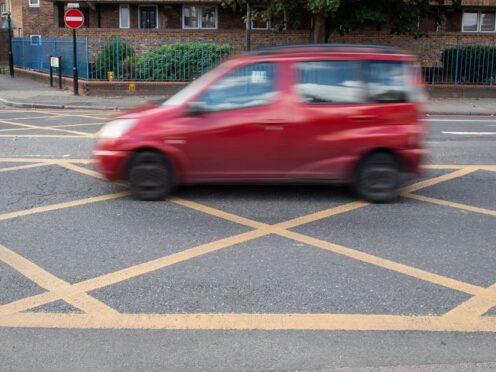Nearly all yellow box road junctions responsible for generating the most fines in London and Cardiff are larger than necessary, according to new research.
The RAC said the analysis it commissioned shows drivers risk being “fined unnecessarily” when their actions “haven’t contributed to congestion”.
Yellow boxes are used in an attempt to ensure traffic flows smoothly through busy junctions.
Motorists should not enter them unless their exit is clear or they are waiting to turn right.
London and Cardiff were the only parts of the UK where drivers could be fined for yellow box offences until the Government introduced new legislation in May 2022 to enable councils across England to apply for enforcement powers.
Chartered engineer Sam Wright was commissioned by the RAC to analyse the 100 boxes across London and Cardiff which were responsible for generating the most fines in 2019.
He found that 98 are larger than necessary for their role in preventing queuing vehicles blocking the path of crossing traffic.
The average box is 50% bigger than needed, according to the research.
The RAC and Mr Wright are calling on the Government to urgently refresh its advice to councils about yellow boxes, to make clear where and how they should be used.

RAC spokesman Rod Dennis said: “With more and more councils starting to enforce yellow box junctions, it is absolutely vital that they are designed first and foremost with aiding traffic flow, and that they don’t exist simply to raise revenue from drivers.
“Unfortunately, any box that is bigger than needed – whether that’s due to an oversight on the council’s part or because it was painted on the road many years ago and hasn’t been reviewed – risks drivers being fined unnecessarily when their actions haven’t contributed to congestion.
“We fear that unnecessary penalties are going to mushroom in the coming years as more councils start enforcing yellow boxes, unless a responsible approach to the design and enforcement of them is taken.
“That’s why we need the Government to urgently issue fresh guidance to local authorities.”
On Transport for London’s (TfL) red routes, fines for breaching yellow box rules are £160 (reduced to £80 if paid within 14 days).
The penalty is £130 (reduced to £65 if paid within 14 days) on roads managed by London boroughs.
In Cardiff, and parts of England excluding London where yellow box offences are enforced, the fine is £70 (reduced to £35 if paid within 21 days).
Mr Wright said: “Making sure yellow boxes are the correct size is extremely important when you consider that even a car bumper overhanging part of a box can result in a driver being fined to the tune of up to £160 depending on where they are in the country.
“Yet in so many cases, drivers can’t avoid stopping in them – a good example being where a yellow box is so big that a driver can’t see where it ends.
“Throw in some bad weather that reduces visibility, and the potential for unnecessary fines increases still further.”
A Department for Transport spokeswoman said: “As part of our Plan for Drivers, we are committed to ensuring councils don’t unfairly penalise motorists to raise revenue, and are reviewing our guidance around yellow boxes to tackle overzealous enforcement.”
